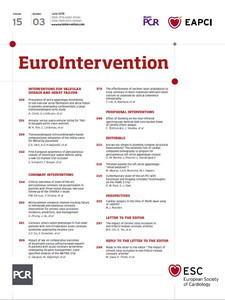We appreciate the interest shown by Chi et al in our article “Prognostic impact of non-culprit chronic total occlusions in infarct-related cardiogenic shock: results of the randomised IABP-SHOCK II trial”1. In their Letter to the Editor “The impact of chronic total occlusion in non-infarct-related coronary arteries”2, Chi et al raise the issue of the presence of coronary chronic total occlusion (CTO) and its effect on the occurrence of ventricular arrhythmia.
Chi et al have conducted a meta-analysis on the impact of CTOs on arrhythmic events and mortality and found that the presence of CTOs was associated with a higher risk of ventricular arrhythmias or appropriate implantable cardioverter-defibrillator therapy3. This meta-analysis (in non-cardiogenic shock patients) is an important addition to the available data, which may relate the occurrence of arrhythmia in patients with CTO to the presence of infarct or scar tissue as a substrate for arrhythmia. This may explain in part the inconsistency in the available data, which did not differentiate in most studies between IRA and non-IRA CTOs.
In the setting of acute myocardial infarction (AMI), infarct size is often larger in the presence of a CTO in a non-IRA, which increases susceptibility to the occurrence of ventricular arrhythmias. This effect may be even more aggravated in the presence of cardiogenic shock. We recently investigated the effect of CTO presence in a non-IRA on myocardial damage assessed by cardiac magnetic resonance imaging in patients with acute ST-elevation myocardial infarction4. These results were consistent with the studies conducted in Japan and Australia mentioned in the authors’ letter reporting higher rates of mortality in this high-risk patient population5,6. Moreover, we found that patients with a CTO in a non-IRA had significantly larger infarcts, a lower myocardial salvage index and lower left ventricular ejection fraction as compared to patients with single-vessel disease or multivessel disease without a CTO, which may explain in part the higher rates of ventricular arrhythmia in these patients.
Unfortunately, data regarding percutaneous coronary intervention for CTOs are inconsistent. Successful CTO recanalisation in stable patients without recent infarctions has been associated with a lower risk of death, stroke, and coronary artery bypass grafting and less recurrent angina pectoris in some registry studies7, whereas in randomised multicentre trials comparing CTO recanalisation to optimal medical therapy major adverse cardiac events (MACE) were comparable at 12 months8.
The same situation is present in patients with acute infarctions. A recent meta-analysis based on registry trials showed a significant reduction in MACE, cardiovascular mortality, and heart failure readmissions after CTO recanalisation of the non-IRA9, whereas in randomised trials CTO revascularisation in a non-IRA after initial reperfusion of the culprit lesion did not result in improved left ventricular function, lower end-diastolic volume or a lower MACE rate when compared with a non-CTO intervention strategy10. We fully agree with the authors that larger-scale prospective trials are needed to explore the benefit of CTO revascularisation in different patient populations.
Conflict of interest statement
The authors have no conflicts of interest to declare.

